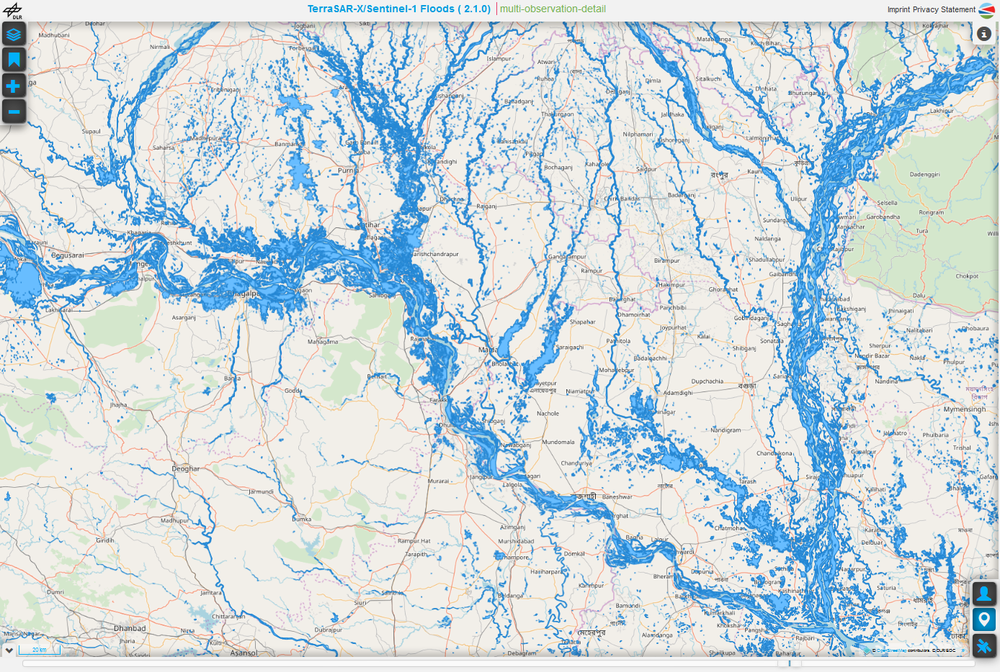Flood Service

The German Remote Sensing Data Center of the DLR operates a system for the detection and monitoring of flood events in near real time. It consists of fully automated process chains for deriving the extent of flood areas based on data from the Sentinel-1 and TerraSAR-X/TanDEM-X radar satellites, the Sentinel-2 and Landsat multi-spectral satellites, various high-resolution optical satellite missions (e.g. GeoEye-1, WorldView-2, WorldView-3) as well as UAV and aerial image data.
The automatic process chains include the following steps: Data integration, pre-processing, calculation and adjustment of global supplementary datasets (for example digital elevation models, terrain slope, topographic indices and reference water masks) as well as the extraction of flood extents.
For the automatic segmentation of flood areas from Sentinel-1 and optical remote sensing data, artificial intelligence models trained by extensive reference datasets are used, while TerraSAR-X/TanDEM-X data are analyzed by an automatic tile-based thresholding approach in combination with a fuzzy logic post-classification process.
While the systematically acquired Sentinel-1/2 and Landsat data allow continuous flood monitoring according to the predefined acquisition plan of the European Space Agency (ESA) or the National Aeronautics and Space Administration (NASA), the flood process chains of higher-resolution satellite missions are activated as soon as the relevant data is recorded over the affected areas (for example, as part of various disaster management mechanisms such as the International Charter "Space and Major Disasters").
Due to development work, the process chains are currently only available internally. However, authorized users can be provided with flood products on request if required.
Related Articles
Bereczky, M., Wieland, M., Krullikowski, C., Martinis, S., Plank, S., 2022. Sentinel-1-based water and flood mapping: Benchmarking Convolutional Neural Networks against an operational rule-based processing chain. IEEE J. Sel. Top. Appl. Earth Obs. Remote Sens., 15, 2023–2036.
Martinis, S., Twele, A., Voigt, S., 2009. Towards operational near real-time flood detection using a split-based automatic thresholding procedure on high resolution TerraSAR-X data. Nat. Hazards Earth Syst. Sci. 9, 303–314.
Martinis, S., Kersten, J., Twele, A., 2015. A fully automated TerraSAR-X based flood service. ISPRS J. Photo. Remote Sens. 104, 203–212.
Martinis, S., Groth, S., Wieland, M., Knopp, L., Rättich, M., 2022. Towards a global seasonal and permanent reference water product from sentinel-1/2 data for improved flood mapping. Remote Sens. Environ. 278, 113077.
Wieland, M., Martinis, S., 2019. A modular processing chain for automated flood monitoring from multi-spectral satellite data. Remote Sens., 11 (19), 2330.
Wieland, M., Fichtner, F., Martinis, S., Groth, S., Krullikowski, C., Plank, S., Motagh, M., 2023. S1S2-Water: A global dataset for semantic segmentation of water bodies from Sentinel-1 and Sentinel-2 satellite images. IEEE J. Sel. Top. Appl. Earth Obs. Remote Sens., 17, 1084–1099.
Wieland M., Martinis S., Kiefl R., Gstaiger V., 2023. Semantic segmentation of water bodies in very high-resolution satellite and aerial images. Remote Sens. Environ., 287.
